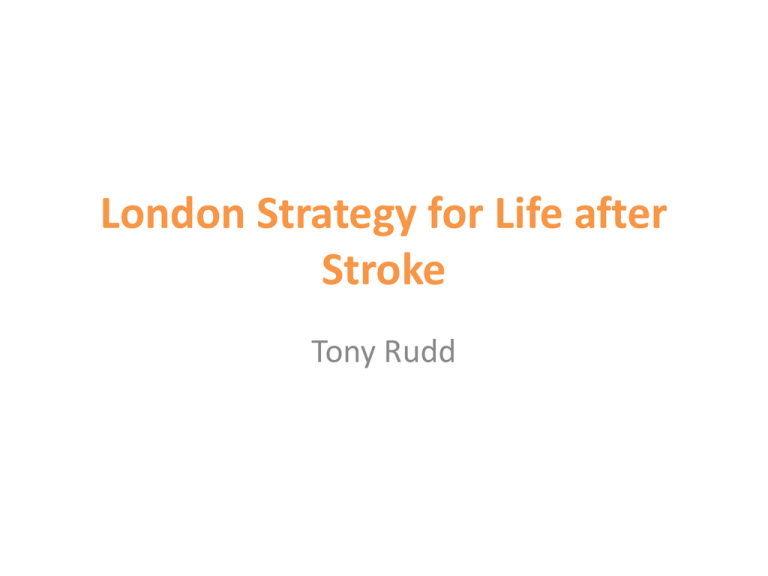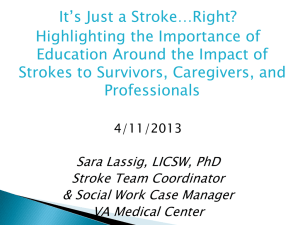London Strategy for life after stroke - Bridges Stroke Self
advertisement

London Strategy for Life after Stroke Tony Rudd Story so far New acute model of care 999 30 min LAS journey* HASU SU After 72 hours HASUs • Provide immediate response • Specialist assessment on arrival • CT and thrombolysis (if appropriate) within 30 minutes • High dependency care and stabilisation • Length of stay less than 72 hours 2 Community Rehabilitation Services Discharge from acute phase Stroke Units • High quality inpatient rehabilitation in local hospital • Multi-therapy rehabilitation • On-going medical supervision • On-site TIA assessment services • Length of stay variable 1 year outcomes % of patients spending 90% of their time on a dedicated SU 90 85 80 % achievement 75 70 London 65 England 60 Target 55 50 45 40 Q1 Q2 Q3 2009/10 Q4 Q1 2010/11 1 year outcomes Average length of stay 20 18 16 14 12 10 8 6 4 2 0 Apr May Jun Jul Aug Sep Oct Nov Dec Jan Feb Mar Apr May Jun 2009/10 2010/11 Jul Aug 1 year outcomes Thrombolysis rates 16% 14% 14% 12% 12% 10% 10% 8% 6% 4% 2% 3.5% 0% Feb-July 2009 Aim Feb-July 2010 Jan-March 2011 Improvements in Community Services Many more areas now have early supported discharge teams Some increase in longer term stroke rehabilitation teams We are reviewing in-patient rehabilitation services London Stroke Survival vs Rest of England Hazard ratio for survival in London 0.72 95%CI 0.67-0.77 p<0.001 The Stroke Association UK Stroke Survivor Needs Survey Christopher McKevitt Reader in Social Science & Health King’s College London Aims 1. To estimate levels of self reported long term need in stroke survivors (1-5 years) 2. To compare levels of need between stroke survivors in England, Scotland, Wales & Northern Ireland Results • 51% reported having no unmet needs • Of those reporting unmet needs, total number per respondent ranged from 1-13, median 3 Information • • • 54%: more information about stroke No differences by age, gender, ethnicity, disability level or time since stroke Significantly different by nation (p=0.009): Northern Ireland=66% Wales=65% England=54% Scotland=49% Unmet health needs N reporting problem (weighted %) Mobility 321 (58.4) Falls 265 (43.9) Incontinence 217 (37.2) Pain 249 (39.5) Emotional 244 (38.4) Speech 194 (34.3) Sight 212 (37.2) Need unmet (%) 25 21 21 15 39 28 26 Need met to some extent (%) 43 47 40 51 34 33 39 Other unmet needs N reporting problem (weighted %) Fatigue Concentration Memory Reading 301 (51.7) 260 (44.7) 260 (42.8) 148 (23.2) Need unmet (%) 43 43 59 34 Need met to some extent (%) 36 41 25 43 Changes in social participation • 52% unable to return to work or reduced hours • Significantly higher in Black and other ethnic groups compared to Whites (p=0.006, population registers) • 67% reported loss in leisure activities • Significantly higher in Black and other ethnic groups compared to Whites (p=0.012, population registers) Impact on finances • 18% of those working at time of stroke reported a loss of income since stroke • 31% reported increased expenses • 16% (25% population registers) reported need for benefits advice Family • 42% reported a negative change in relationship with partner • 26% reported negative changes in family relationships Groups at higher risk? • No differences by • age • gender • time since stroke • Higher unmet need: • disability, including communication disability • ethnic minority stroke survivors • people living in poorest areas Stroke survivors in London ‘denied recovery’ says new report calling for better coordination and support ‘Stroke survivors across London say they are being denied the chance to make their best recovery because of a lack of patchy post hospital care and confusion between health and social care services, states a new national report published today (Tuesday May 1st 2012) by the Stroke Association.’ Stroke Association Survey Findings •85% of stroke survivors say that the impact of stroke is not understood •Six out of ten (59%) said that health and social care services did not work well together resulting in families and carers having to take responsibility for coordinating care. •Almost a third (31%) reported services being reduced or withdrawn even though their needs had stayed the same or had increased. Stroke Association Survey Findings 38% felt they did not receive enough support from NHS services Almost a third (31%) reported services being reduced or withdrawn even though their needs had stayed the same or had increased. 77% are unable to get out as much since they had their stroke. Life After Stroke Commissioning Guide London stroke strategy – where this fits London stroke strategy (2008) Public consultation (2008/09) Rehab commissioning guide (2009) Life after stroke (2010) Principles Active citizenship Quality of life Empowerment Scale of need 6,000 Sum of stroke and TIA patients in a GP register in 2008/9 5,000 4,000 3,000 2,000 1,000 • Prevalence ranges from 1.6% to 0.8% of registered GP population • 88,000 people across London on GP registers have had a stroke or TIA Diverse needs 15% have on-going continence problems 25% of nursing home residents have had a stroke 33% of stroke survivors report depressive symptoms 20% “silent stroke” – underlying cognitive problems Regular review Needs change over time Recognise variability of needs and aspirations National guidance – 12 monthly review Structured social group Social care Therapist Stroke survivor GP Stroke navigator Information Stroke care navigator Single point of contact Direct role in delivering care Coordinate care packages Training stroke survivors and carers Work across different sectors London stroke directory www.londonstrokedirectory.org.uk Engaging with community life Stroke survivors do not get out of the home as much as they would like Building confidence Addressing practical issues Community/social groups have benefits beyond primary purpose Peer support & peer-led services Improve emotional wellbeing Build capacity Source of information Sense of purpose Confidence Range of functions Peer support Improve functional status Carers and families Carers have a right to their own needs review Training and education should be provided Local authority and charitable sector support is available Conclusions Stroke care is better in London as a result of the stroke reorganisation BUT...... Still failing to meet longer terms needs of people after stroke There is no additional money for changing these services Need to persuade commissioners that these are services that are worth investing in for both clinical and economic reasons Major concerns that government cuts will negatively affect the resources available to people for longer term support






